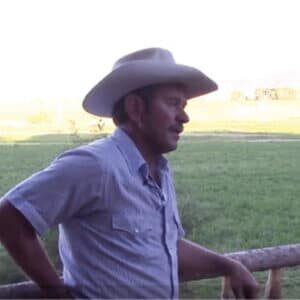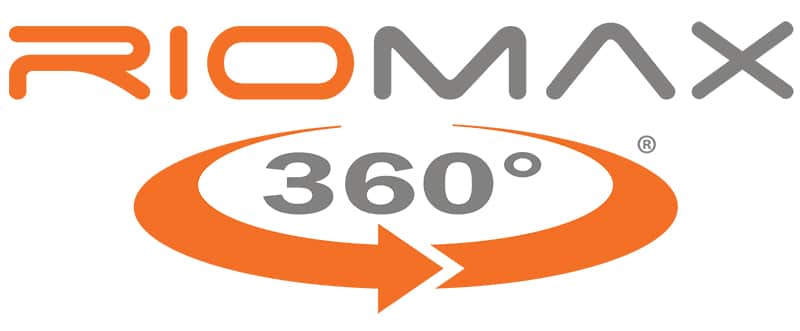Last updated on April 28th, 2022 at 10:03 am
Taking the "crazy" out of ranching
you don't have to be crazy to be a rancher. just smart.
MEET LARRY CHAMBERLAIN
Medicine Bow Buffalo
Douglas, Wyoming

You don’t have to be crazy to be a rancher. Just smart.
“My dad always said you don’t have to be crazy to be in the ranching business, but it sure helps. This is a tough area to produce calves, but I was born here; this is my heritage going back generations.”
That, says Larry Chamberlain of Douglas, Wyoming, describes ranching on the weather-worn and windy Wyoming plains. It’s the High Lonesome where the precipitation that comes is usually frozen and arrives horizontally. “At one mile above sea level, we experience tough conditions due to cold, too much moisture in the winter then too little moisture during the growing season.”
Chamberlain runs 250 mother cows on windswept winter range and summers the pairs in the mountains at 6,000 to 8,000 feet. “We raise black baldy calves from Hereford and Black Angus cattle,” he says. “They tend to be hardy, but hardiness alone can’t withstand unrelenting weather.”
Especially when drought enters a picture already cloudy with harsh weather.
Larry is no stranger to the devastation of drought.
“It’s been a make-or-break situation,” Chamberlain said during a Riomax® webinar in the summer of 2020. “Since 2012, we learned the hard way about just how tough this country can get.”
A bone-bleaching drought began that year, following a 2006 drought that was bad enough. That convinced Chamberlain he needed to do something to help his pairs get through a summer with very poor grazing. That “something” turned out to be a year-round mineral supplementation program.
He’s been on the program ever since.
That’s because of the results he sees, not just in how it stretches pasture and hay supplies, but in just about every area of his cattle operation. “In 2012, we were amazed that the calves’ weaning weights were as good as we’ve ever had.”
Ranching in mountain country.
Chamberlain also runs a small bison herd. Because those cows are seasonally polyestrous, they calve in synch with nature. Not so with their domestic cousins.
“On account of the way our operation is here, we really don’t have any choice but to calve at a point where we can get those cows and calves to (summer) pasture,” he says. “Because our envelope is so short to utilize the mountain country, we’ve got to get those calves up and ready to go by May.”
That means calving in the teeth of late winter weather. And dealing with the resulting health issues.
Scouring calves
“We have many years of experience of fighting scours in these young calves. And for a long time, we suffered badly with enterotoxemia, what a lot of people refer to as purple gut,” he says. “I can tell you that if the cattle are consistently on the Rio tubs, bloody scours are not a problem.” Ditto for entrotoxemia.
And just because he can get through calving season without any death loss doesn’t mean he’s done with health problems. Even on summer pasture, cattle can find ways to create health challenges.
WHEN DROUGHT HITS...
WHERE SHOULD YOU SPEND & WHERE SHOULD YOU SAVE?
Summer pasture problems
Take, for instance, foot rot, which his Hereford bulls are susceptible to. “It’s no fun trying to treat foot rot,” he says. “You try to find a pine tree you can get him close to, rope him and get him snubbed up to the tree without getting yourself killed. And since we’ve been on the tubs, we have not treated a bull.”
Likewise, black-hided calves would mysteriously die during the summer and fall, likely from pneumonia. “You’ll just find these nice, big, black steers dead,” he says. “But we have not experienced death loss with any of these calves if they are consistently on the tubs.”
Chamberlain sells weaned and preconditioned calves, which typically bring a $4 to $6 per cwt premium over unweaned and unvaccinated calves. Even on mountain summer pastures, those calves don’t see a lot of green grazing. Yet, when they hit Chamberlain’s preconditioning feedlot at the home place, he expects them to average around 2.3 pounds per day gain on nothing more than hay and small grain sileage.
Creating an efficient & productive herd
Being on the mineral program since birth makes weaning easier, teaches the calves to eat something besides grass, and primes their gut for the preconditioning diet. Weaning weights since 2012, regardless of grazing conditions, continue to stay around 50 pounds heavier than his pre-2012 experience.
Then there are his replacement heifers. Asking a mature cow to calve, go through post-calving recovery and rebreed all in 365 days on tough country is hard enough.
“Where you run into trouble, you have the expensive replacement heifers. Not too much trouble with the breed-up on the yearlings, but then they have their first calf,” he says. “And here’s a nice heifer and she comes up open (as a two-year-old). She’s put a lot of her subsidence into raising that first calf and she just doesn’t have it in her body to go ahead and re-breed.”
In 2019, however, he had 100% breed-up in his two-year-old heifers. “Just another example of something being different about the mineral program,” he says. “And it brings out the necessity to keep the cattle, not just sporadically on the tub, but continually.”



